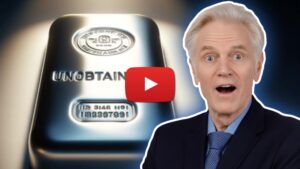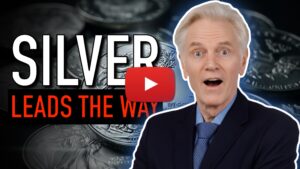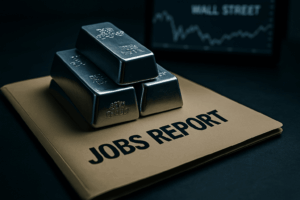Is socialism “on the way”… or has the United States already crossed the line without admitting it?
In a recent episode of The GoldSilver Show, Mike Maloney and Alan Hibbard tackle a question most people only debate on social media — but they back it with real examples, real incentives, and real-world consequences. What they reveal is uncomfortable: many of the structures, incentives, and policies we live under today already resemble textbook socialism, even if the label is never used.
Here’s a breakdown of the core insights from the conversation — and why they matter to anyone trying to protect their financial independence.
The Quote That Sparked the Conversation
Alan kicks off the episode with a tweet quoting a politician who proudly declared:
“There is no problem too large for government to solve and no concern too small for it to care about.”
For Alan and Mike, the second half of that sentence is the red flag.
If no concern is too small for the government to intervene in, that implies total intrusion into daily life — the exact opposite of voluntary exchange, the foundation of capitalism.
Mike points out that this mindset mirrors what eventually consumed centralized economies like the USSR and Mao-era China: the belief that central planners can manage every detail better than individuals.
Once the government signals that everything is its jurisdiction, “creeping socialism” is no longer creeping — it’s embedded.
Capitalism vs. Socialism: The Real Definitions
To frame the discussion, Alan lays out the simplest breakdown possible:
Socialism:
- Centralized ownership and control of production
- Distribution based on “communal priorities”
- The group > the individual
- Decisions enforced by government power
Capitalism:
- Private ownership of resources
- Voluntary exchange
- Prices based on supply and demand
- The individual > the group
Mike drives home one key word: voluntary.
You don’t need a gun, a mandate, or a bureaucrat to make capitalism work.
You only need two people who agree to exchange value.
When an economic system requires force, coercion, or penalty to function, it’s drifting away from capitalism — no matter what politicians call it.
“Socialism Isn’t Coming — It’s Already Here”
Alan stresses one of the central points of the episode:
We shouldn’t fear the socialism that might come next decade.
We should fear the socialism we already have today.
They examine U.S. industries and categorize how “capitalist” or “socialist” their structures actually are. The results aren’t flattering.
According to the discussion, the following sectors already operate as fully or near-fully socialist systems:
- K–12 public education
- The military
- USPS
- Veteran healthcare
- Public housing
- Medicare / Medicaid
- SNAP and food assistance programs
- Utilities in many states
This isn’t about ideology — it’s about ownership and control.
In many major parts of American life, the government is already the provider, the regulator, the payer, and the enforcer.
The danger isn’t that socialism is coming. It’s that most people don’t notice how much of it is already normalized.
Incentives Make (or Break) an Economy
Mike shares a real-world example from Puerto Rico: Legal employers can’t compete with the incentive structure of government benefits.
If someone accepts a legitimate job—as opposed to working for cash—they lose food stamps, subsidized housing, and other benefits. The rational choice becomes avoiding legal employment.
This is the predictable outcome of a socialist-style incentive system:
- Productivity is punished.
- Dependence is rewarded.
- Illegal or off-the-books activity becomes widespread.
As Mike puts it: people will always respond to incentives — good or bad.
The System Has Shifted — Now What?
Whether you agree with Mike and Alan or not, the evidence is hard to ignore:
- Programs have expanded.
- Incentives have warped.
- Money creation is out of control.
- Political parties no longer change outcomes — the system does.
And the drift toward centralized control is happening quietly, piece by piece.
Understanding these forces isn’t just political — it’s financial.
Your savings, purchasing power, investments, and future all depend on seeing these shifts clearly.
To hear Mike and Alan’s full breakdown — including the charts, examples, and deeper insights — watch the complete episode here:
👉 Watch the full video: “Here Comes Socialism — Or Is It Already Here?”
People Also Ask
What’s the difference between socialism and capitalism?
Socialism centralizes ownership and decision-making, distributing resources according to government priorities. Capitalism is based on voluntary exchange and private ownership, allowing prices and incentives to emerge naturally from the market. According to Mike and Alan, the key distinction is that capitalism doesn’t require force — socialism does.
How does fiat money contribute to socialism?
A fiat currency system lets the government create money without limit, enabling rapid expansion of programs, redistribution, and central planning. Mike Maloney argues that once politicians can “type money into existence,” socialist incentives become unavoidable. Gold, by contrast, imposes natural discipline because it cannot be printed.
How do tariffs and government “dividends” fit into a socialist model?
When tariff revenue is redistributed as cash payments, it functions as wealth transfer from one group to another. In this case, consumers and importers pay the tax, but lower-income recipients receive the payouts — excluding many of the people who funded it. Mike and Alan explain that this is centrally planned redistribution, not market-based capitalism.
Is socialism already happening in the United States?
Yes. Many U.S. sectors already operate under centralized government control — including K–12 education, the postal system, veteran healthcare, public housing, and major welfare programs. Mike Maloney and Alan Hibbard argue that these structures reveal socialism isn’t “coming,” it’s already embedded in daily life.
What incentives are causing people to avoid legal employment?
Government benefits such as food assistance and subsidized housing can be lost when someone takes a legal, taxable job. This creates a system where working off the books pays more than working legally. Mike explains that this is a predictable outcome of socialist incentive structures — people simply respond to the rewards offered.








